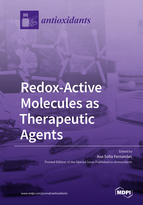Redox-Active Molecules as Therapeutic Agents
A special issue of Antioxidants (ISSN 2076-3921). This special issue belongs to the section "Health Outcomes of Antioxidants and Oxidative Stress".
Deadline for manuscript submissions: closed (31 January 2021) | Viewed by 50653
Special Issue Editor
Special Issue Information
Dear Colleagues,
Oxidative stress and altered redox signaling have been described in a plethora of pathological conditions, such as inflammation, cardiovascular diseases, diabetes, cancer, and neurodegenerative disorders, among others. The concept of redox-active therapeutics explores the potential usefulness of redox-active molecules to modulate the progression of such diseases. Although the therapeutic potential of many natural and synthetic compounds has been suggested for decades, recent advances in molecular biology and pharmacology, including the omics approaches, have strengthened this field of research by providing novel mechanistic insights, especially regarding the redox modulation of critical signaling pathways.
This Special Issue aims at publishing state-of-the-art research related to the therapeutic potential of redox-active molecules in a broad perspective, covering from basic science to clinical research, focused on the potential effects of either natural or synthetic compounds on different redox-related diseases. Researchers are invited to submit original research articles and reviews to this Special Issue.
I look forward to receiving your contributions.
Yours sincerely,
Dr. Ana Sofia Fernandes
Guest Editor
Manuscript Submission Information
Manuscripts should be submitted online at www.mdpi.com by registering and logging in to this website. Once you are registered, click here to go to the submission form. Manuscripts can be submitted until the deadline. All submissions that pass pre-check are peer-reviewed. Accepted papers will be published continuously in the journal (as soon as accepted) and will be listed together on the special issue website. Research articles, review articles as well as short communications are invited. For planned papers, a title and short abstract (about 100 words) can be sent to the Editorial Office for announcement on this website.
Submitted manuscripts should not have been published previously, nor be under consideration for publication elsewhere (except conference proceedings papers). All manuscripts are thoroughly refereed through a single-blind peer-review process. A guide for authors and other relevant information for submission of manuscripts is available on the Instructions for Authors page. Antioxidants is an international peer-reviewed open access monthly journal published by MDPI.
Please visit the Instructions for Authors page before submitting a manuscript. The Article Processing Charge (APC) for publication in this open access journal is 2900 CHF (Swiss Francs). Submitted papers should be well formatted and use good English. Authors may use MDPI's English editing service prior to publication or during author revisions.
Keywords
- Redox-related diseases
- Drug discovery
- Synthetic redox-active compounds
- Natural redox-active compounds
- Mechanisms of action







